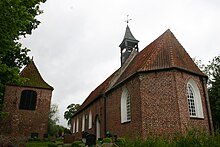Jennelter Church
The Evangelical Reformed Jennelter Church is in the East Frisian town of Jennelt , in the Krummhörn .
history
The terp village Jennelt is first known as Geinleth in the 8th / 9th. Century mentioned. It is therefore assumed that today's church had a previous building, of which no traces have yet been discovered. The current building was built in the last half of the 13th century as a one-room church on the west side of the elongated village wharf.
After the Reformation , the community professed the Reformed Faith . The church was adapted to the new needs. All sculptures were removed and the building was converted into a sermon church. The pulpit was placed in the center on the south side. The benches facing them were grouped around them. On the west and east sides, slightly raised, were the benches for the farming families. The Lord's Supper was celebrated in the separate choir room.
In the late 16th century the place fell to the Innhausen and Knyphausen families . Under their rule, the place became a glory . The most important representative of the family, Dodo zu Inn- und Knyphausen , had the polygonal choir and the crypt added to the church around 1604 . The members of the noble family should be buried there in future. After his death in the Battle of Haselünne in 1636, Dodo was buried in a magnificent coffin in Jennelt. His wife, Anna von Schade , also found her final resting place in the crypt.
In 1971 the church was rebuilt again. The entrance was moved to its current location and walls were pulled into the building. This created a hallway, a group room and a church room. Only a remnant of the pulpit and the communion table have been preserved from the original furnishings.
Building description
The Jennelter Church is a one-room church that was originally built in the Romanesque style. A roof turret is placed on the east end of the ridge. The choir and nave are clearly separated from each other by a construction seam . Inside, only a narrow passage connects both parts of the building, of which the choir is about 60 cm higher than the nave. At the time of its construction, the building had entrances on the north and south sides. The portal on the south side was under an inscription from 1870, the remains of a door threshold can still be seen at the north entrance. Apparently there was another, larger entrance on the west side. Today the church is entered through a south portal. Until the choir was added, the altar was on the east side of the church.
There is some evidence that there was also a small brick vault in this area of the church.
Some of the originally narrow Romanesque windows have been preserved in the choir on the former east gable. The remainder were enlarged after the Reformation to let more light into the building. These pointed arched windows without tracery give the church its current, late Gothic appearance.
To the south of the main building is a closed-type bell tower.
Furnishing
In the crypt there are two art-historically significant baroque sarcophagi , of which the one for Dodo zu Inn- and Knyphausen is decorated with copper drifting, while the one for his son Adam is made entirely of copper and is decorated with tendril paintings and depictions of the virtues. The other sarcophagi are also made of copper and are works of the 17th century.
organ
The organ dates from 1738 and was built by Johann Friedrich Constabel . It has only been in Jennelt since 1970. It is originally installed in the Bargebur Church . After Bargebur received a larger instrument, the organ was sold to Hamswehrum in 1864 and installed in the local St. Maria Church . In 1969 the organ was restored by Ahrend & Brunzema and then placed on the floor in front of the west wall in Jennelt. The instrument has eight registers on a manual and attached pedal . The disposition is as follows:
|
|
||||||||||||||||||||||||||||||||||||||||||||||
C = Johann Friedrich Constabel, Wittmund (1738)
A = Ahrend & Brunzema, Loga (1969)
See also
literature
- Hans-Bernd Rödiger, Heinz Ramm: Frisian churches in Auricherland, Norderland, Brokmerland and in Krummhörn , Volume 2. Verlag CL Mettcker & Söhne, Jever (2nd edition) 1983, p. 62.
Web links
- Evangelical Reformed Church Jennelt. A walk through church and history (PDF file; 261 kB)
- reformiert.de: Ev.-ref. Jennelt parish
- Local chronicle of the East Frisian landscape : Jennelt (PDF file; 26 kB)
- Genealogy forum: Jennelt, Krummhörn community, Aurich district
- Churches funded by the KiBa Foundation: Ev.-ref. Jennelt Church , accessed September 8, 2018.
Individual evidence
- ↑ a b Organ on NOMINE eV , seen April 22, 2011.
- ↑ a b c d e f Evangelical Reformed Church Jennelt. A walk through church and history ( Memento from January 16, 2016 in the Internet Archive ) (PDF file; 261 kB), viewed on June 5, 2012.
- ^ Genealogy forum: Jennelt, Krummhörn community, Aurich district ( memorial from November 23, 2007 in the Internet Archive ), viewed on May 9, 2011.
- ^ A b Georg Dehio: Dehio - Handbook of German Art Monuments: Handbook of German Art Monuments, Bremen, Lower Saxony . German art publisher; Edition: revision, greatly expanded edition. Munich, Berlin (January 1, 1992). ISBN 3-422-03022-0 . P. 782
- ↑ Gottfried Kiesow : Architectural Guide Ostfriesland . Verlag Deutsche Stiftung Denkmalschutz , Bonn 2010, ISBN 978-3-86795-021-3 , p. 103.
Coordinates: 53 ° 27 '47.2 " N , 7 ° 7' 55.9" E


